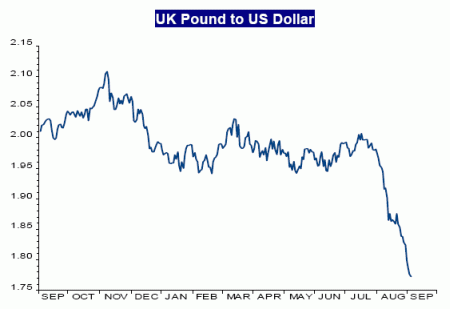
The Chancellor of the Exchequer has changed horses from his “optimistic” Budget in March to a potential “hard landing” scenario which could be presented in his 2008 pre-budget report. Last week, Alistair Darling warned that “we face a unique set of circumstances that we have not seen for generations where you have a credit crunch and you have high oil and food prices” and that the economic slowdown will be more profound and longer lasting than people thought.”
So its almost official, a recession has arrived and it is already incorporated into most private sector forecasts e.g. OECD estimates a UK recession in the second half of 2008. UK recessions do not come often with the last three occurring in 1991, 1982 and 1974. In our view, some financial markets have started to discount this event e.g. the pound has fallen by 8% in August and some equity sectors have already priced in a hard landing. The consensus view appear to be a “mild and “quick” UK recession but could this be too optimistic? The credit markets seem to think so and in October, the Bank of England’s £50bn Special Liquidity Scheme closes.
The UK Treasury will have the opportunity to slash its economic growth forecasts in the pre-budget report due in October. In the March 2008 budget, it was stated that “The UK is the only G7 economy to have avoided any single quarter of negative growth over the past decade. The flexibility and resilience of the UK economy provides a solid platform from which to face the global economic shocks from the continued disruption in global financial markets and the increase in energy and commodity prices. UK GDP growth is forecast to slow from 3 per cent in 2007 to 1¾ to 2¼ per cent in 2008, before picking up to 2¼ to 2¾ per cent in 2009 and 2½ to 3 per cent in 2010.”
When those Treasury forecasts were made, the City believed that the Government was being too optimistic. In March, the consensus GDP estimate among private sector forecasts was for 1.9% growth in 2008 and +2% in 2009. The current consensus has moved to +1.4% for 2008 followed by +1% in 2009.
Behind this consensus, many forecasters now expect a recession as defined by two negative quarters of GDP growth. Even the Bank of England admitted that a technical recession was very likely when it published its Inflation Report in August. Therefore, Mr Darling’s new prognosis is not too dissimilar to that of the central bank. Recent publication of Q2 GDP figures showed flat UK output and clearly the prospect of a recession was a major reason for Sterling declining by 8% in August and its continuing weakness (see chart below).
The OECD estimates that of all the G7 countries only the UK will show GDP contracting in Q3 and Q4. The OECD admits there could be some volatility around its forecasts but some forecasters are even more pessimistic. For example, Capital Economics expect an outright decline in GDP of 0.2% in 2009 compared to most others expecting 1% growth. Capital’s more pessimistic forecasts are derived from its analysis of banks capital requirements. The banks need to raise about £65bn of new capital to maintain lending but have only raised £20bn, so far. In April, the Bank of England put in place a Special Liquidity Scheme to help liquidity but this closes in October and will not be extended. With libor rates remaining elevated and UK banks still needing to reduce mortgage/property exposure and raise further capital, the credit crunch is likely to continue to impact the economy.
Although the OECD only expects the UK to slip into a recession, risks have increased around the world. In the eurozone, Q2 GDP contracted by 0.2%, the first fall since 1999. In Japan, recent GDP declined by 0.6%. Although US Q2 GDP growth was upgraded to 3.3% from an initial estimate of +1.9%, almost all of the upgrade to the GDP figure came from the revision of export data. Meanwhile, consumer spending of +1.7% has been buoyed by tax rebates. Capital expenditure fell by 3.2% and of course housing is a big drag. The US economy remains on the edge of a recession and with credit problems intensifying (10 banks have failed in 2008 and the Federal Deposit Insurance Corporation said 117 banks were considered to be in trouble in Q2 compared to 90 in Q1) the upcoming jobs reports and unemployment will be critical data points.
In conclusion, the slump in the pound is the clearest financial signal that the UK faces a recession but a weaker currency could also provide some support for exporters as it has done in the US. A recession may still be avoided but clearly the risk of a prolonged economic and credit downturn is yet to be fully discounted in corporate earnings estimates.
Some positive factors are that equity valuations are low so we do not see much downside and there should be scope for a strong monetary stimulus from the MPC, at some stage. Although the MPC left interest rates at 5% in September, a sharp reduction in CPI over coming months should allow the MPC to reduce interest rates in 2009. Next week, two of the hardest hit UK equity sectors will be in focus with results from house builders (Barratt Developments and Redrow) and retailers (Next, Kesa Electricals and Home Retail).
By Jeremy Batstone-Carr, Director of Private Client Research at Charles Stanley